How to Register Dll Files in Windows 8
What is Register.dll? What Does It Do?
The Register.dll library is 0.08 MB. The download links are current and no negative feedback has been received by users. It has been downloaded 3724 times since release and it has received 5.0 out of 5 stars.
Table of Contents
- What is Register.dll? What Does It Do?
- Operating Systems Compatible with the Register.dll Library
- How to Download Register.dll
- Methods to Fix the Register.dll Errors
- Method 1: Installing the Register.dll Library to the Windows System Directory
- Method 2: Copying the Register.dll Library to the Program Installation Directory
- Method 3: Doing a Clean Install of the program That Is Giving the Register.dll Error
- Method 4: Fixing the Register.dll error with the Windows System File Checker
- Method 5: Fixing the Register.dll Error by Updating Windows
- Windows Update Guides
- The Most Seen Register.dll Errors
- Other Dynamic Link Libraries Used with Register.dll
Operating Systems Compatible with the Register.dll Library
- Windows 10
- Windows 8.1
- Windows 8
- Windows 7
- Windows Vista
- Windows XP
How to Download Register.dll
- Click on the green-colored "Download" button (The button marked in the picture below).

Step 1:Starting the download process for Register.dll - When you click the "Download" button, the "Downloading" window will open. Don't close this window until the download process begins. The download process will begin in a few seconds based on your Internet speed and computer.
Methods to Fix the Register.dll Errors
ATTENTION! Before starting the installation, the Register.dll library needs to be downloaded. If you have not downloaded it, download the library before continuing with the installation steps. If you don't know how to download it, you can immediately browse the dll download guide above.
Method 1: Installing the Register.dll Library to the Windows System Directory
- The file you downloaded is a compressed file with the extension ".zip". This file cannot be installed. To be able to install it, first you need to extract the dynamic link library from within it. So, first double-click the file with the ".zip" extension and open the file.
- You will see the library named "Register.dll" in the window that opens. This is the library you need to install. Click on the dynamic link library with the left button of the mouse. By doing this, you select the library.
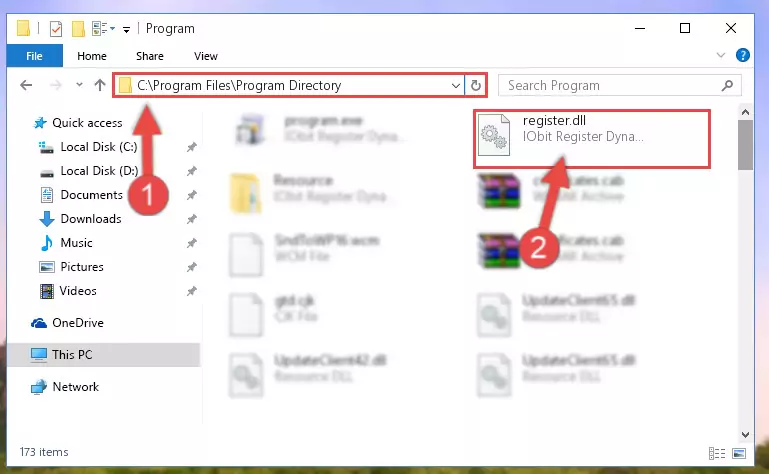
Step 2:Choosing the Register.dll library - Click on the "Extract To" button, which is marked in the picture. In order to do this, you will need the Winrar program. If you don't have the program, it can be found doing a quick search on the Internet and you can download it (The Winrar program is free).
- After clicking the "Extract to" button, a window where you can choose the location you want will open. Choose the "Desktop" location in this window and extract the dynamic link library to the desktop by clicking the "Ok" button.
- Copy the "Register.dll" library you extracted and paste it into the "C:\Windows\System32" directory.
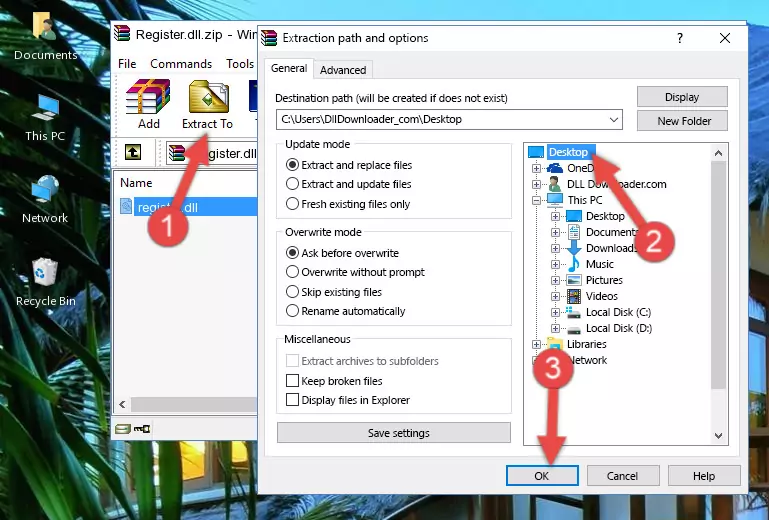
Step 3:Copying the Register.dll library into the Windows/System32 directory - If your system is 64 Bit, copy the "Register.dll" library and paste it into "C:\Windows\sysWOW64" directory.
NOTE! On 64 Bit systems, you must copy the dynamic link library to both the "sysWOW64" and "System32" directories. In other words, both directories need the "Register.dll" library.
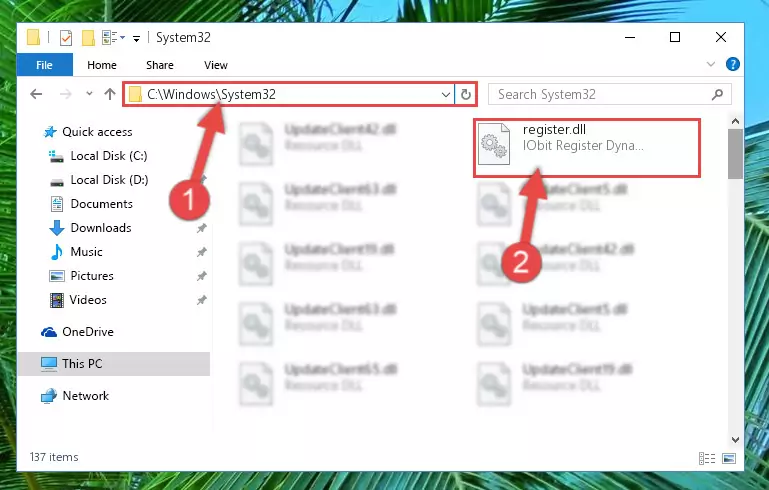
Step 4:Copying the Register.dll library to the Windows/sysWOW64 directory - In order to complete this step, you must run the Command Prompt as administrator. In order to do this, all you have to do is follow the steps below.
NOTE! We ran the Command Prompt using Windows 10. If you are using Windows 8.1, Windows 8, Windows 7, Windows Vista or Windows XP, you can use the same method to run the Command Prompt as administrator.
- Open the Start Menu and before clicking anywhere, type "cmd" on your keyboard. This process will enable you to run a search through the Start Menu. We also typed in "cmd" to bring up the Command Prompt.
- Right-click the "Command Prompt" search result that comes up and click the Run as administrator" option.

Step 5:Running the Command Prompt as administrator - Let's copy the command below and paste it in the Command Line that comes up, then let's press Enter. This command deletes the Register.dll library's problematic registry in the Windows Registry Editor (The library that we copied to the System32 directory does not perform any action with the library, it just deletes the registry in the Windows Registry Editor. The library that we pasted into the System32 directory will not be damaged).
%windir%\System32\regsvr32.exe /u Register.dll
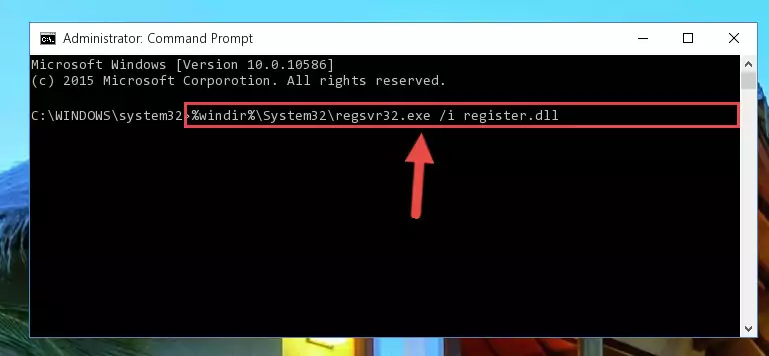
Step 6:Deleting the Register.dll library's problematic registry in the Windows Registry Editor - If you have a 64 Bit operating system, after running the command above, you must run the command below. This command will clean the Register.dll library's damaged registry in 64 Bit as well (The cleaning process will be in the registries in the Registry Editor< only. In other words, the dll file you paste into the SysWoW64 folder will stay as it).
%windir%\SysWoW64\regsvr32.exe /u Register.dll
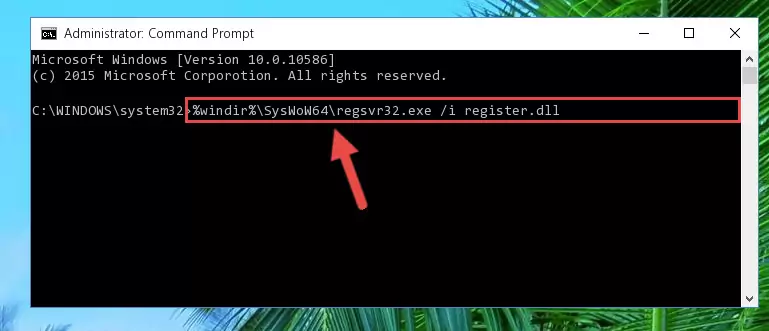
Step 7:Uninstalling the Register.dll library's broken registry from the Registry Editor (for 64 Bit) - In order to cleanly recreate the dll library's registry that we deleted, copy the command below and paste it into the Command Line and hit Enter.
%windir%\System32\regsvr32.exe /i Register.dll
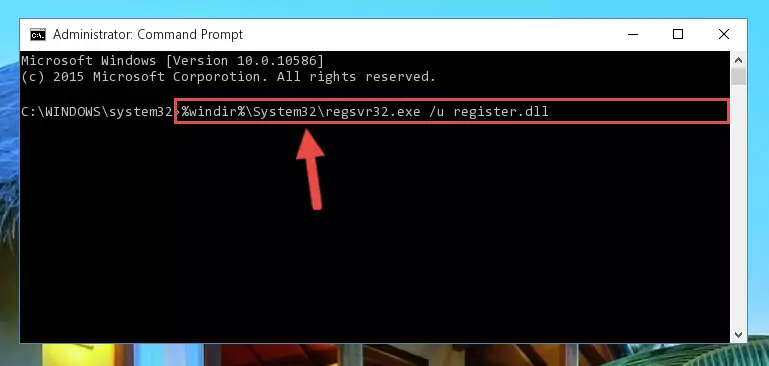
Step 8:Reregistering the Register.dll library in the system - If you are using a 64 Bit operating system, after running the command above, you also need to run the command below. With this command, we will have added a new library in place of the damaged Register.dll library that we deleted.
%windir%\SysWoW64\regsvr32.exe /i Register.dll
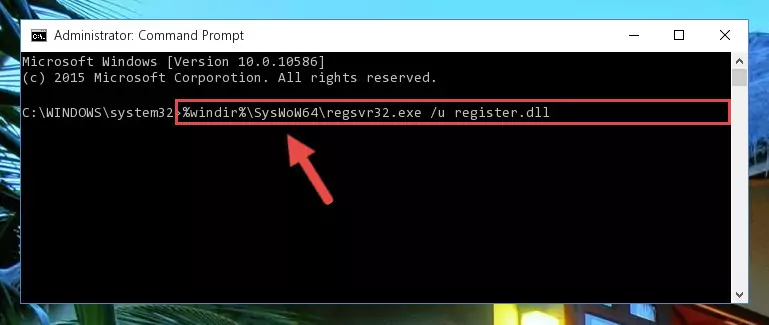
Step 9:Reregistering the Register.dll library in the system (for 64 Bit) - You may see certain error messages when running the commands from the command line. These errors will not prevent the installation of the Register.dll library. In other words, the installation will finish, but it may give some errors because of certain incompatibilities. After restarting your computer, to see if the installation was successful or not, try running the program that was giving the dll error again. If you continue to get the errors when running the program after the installation, you can try the 2nd Method as an alternative.
Method 5: Fixing the Register.dll Error by Updating Windows
Most of the time, programs have been programmed to use the most recent dynamic link libraries. If your operating system is not updated, these files cannot be provided and dll errors appear. So, we will try to fix the dll errors by updating the operating system.
Since the methods to update Windows versions are different from each other, we found it appropriate to prepare a separate article for each Windows version. You can get our update article that relates to your operating system version by using the links below.
Windows Update Guides
- Windows Update Guide
- Windows 8.1 and Windows 8 Update Guide
- Windows 7 and Windows Vista Update Guide
- Windows XP Update Guide
The Most Seen Register.dll Errors
It's possible that during the programs' installation or while using them, the Register.dll library was damaged or deleted. You can generally see error messages listed below or similar ones in situations like this.
These errors we see are not unsolvable. If you've also received an error message like this, first you must download the Register.dll library by clicking the "Download" button in this page's top section. After downloading the library, you should install the library and complete the solution methods explained a little bit above on this page and mount it in Windows. If you do not have a hardware issue, one of the methods explained in this article will fix your issue.
- "Register.dll not found." error
- "The file Register.dll is missing." error
- "Register.dll access violation." error
- "Cannot register Register.dll." error
- "Cannot find Register.dll." error
- "This application failed to start because Register.dll was not found. Re-installing the application may fix this problem." error
Other Dynamic Link Libraries Used with Register.dll
- Regdir.dll
- Registry.dll
- Regstr.dll
- Npdjvu.dll
- Npdrmv2.dll
How to Register Dll Files in Windows 8
Source: https://www.dlldownloader.com/register-dll/